Children, Youth, and Family Welfare Systems & Services: Case Study
VerifiedAdded on 2023/06/10
|7
|1722
|221
Report
AI Summary
This report presents a case study analysis of a 21-year-old male client within the context of Australian Children, Youth, and Family Welfare Systems and Services. The client has a history of family violence, foster care, and struggles with identity, peer pressure, and substance abuse. The report references key governmental and non-governmental organizations like the NSW Department of Family and Community Services and the Department of Social Services, highlighting programs such as "Keep Them Safe" and "Their Future Matters," which aim to improve the safety and wellbeing of children and families. It explores services for the homeless, disabled, and young offenders, including juvenile justice centers and legal aid. The report emphasizes the importance of community-based intervention programs, drug and alcohol rehabilitation, and the role of social workers in supporting clients. References include academic sources that discuss child protection, inter-agency collaboration, and community-university partnerships. The report concludes by summarizing the various legal frameworks and community services available to support vulnerable populations, including the Aboriginal and Torres Strait Islander people, and offering financial and job benefits.
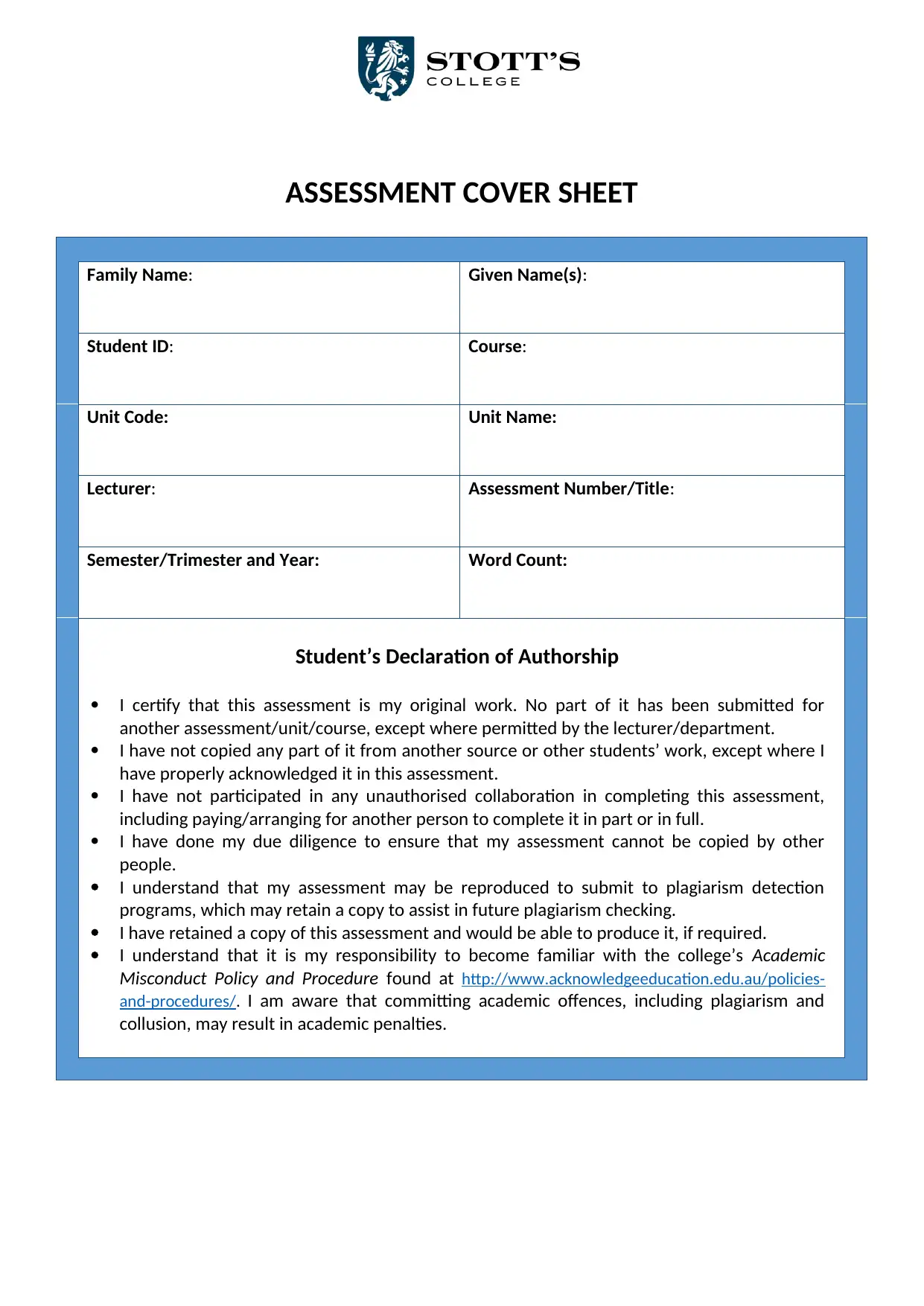
ASSESSMENT COVER SHEET
Family Name: Given Name(s):
Student ID: Course:
Unit Code: Unit Name:
Lecturer: Assessment Number/Title:
Semester/Trimester and Year: Word Count:
Student’s Declaration of Authorship
I certify that this assessment is my original work. No part of it has been submitted for
another assessment/unit/course, except where permitted by the lecturer/department.
I have not copied any part of it from another source or other students’ work, except where I
have properly acknowledged it in this assessment.
I have not participated in any unauthorised collaboration in completing this assessment,
including paying/arranging for another person to complete it in part or in full.
I have done my due diligence to ensure that my assessment cannot be copied by other
people.
I understand that my assessment may be reproduced to submit to plagiarism detection
programs, which may retain a copy to assist in future plagiarism checking.
I have retained a copy of this assessment and would be able to produce it, if required.
I understand that it is my responsibility to become familiar with the college’s Academic
Misconduct Policy and Procedure found at http://www.acknowledgeeducation.edu.au/policies-
and-procedures/. I am aware that committing academic offences, including plagiarism and
collusion, may result in academic penalties.
Family Name: Given Name(s):
Student ID: Course:
Unit Code: Unit Name:
Lecturer: Assessment Number/Title:
Semester/Trimester and Year: Word Count:
Student’s Declaration of Authorship
I certify that this assessment is my original work. No part of it has been submitted for
another assessment/unit/course, except where permitted by the lecturer/department.
I have not copied any part of it from another source or other students’ work, except where I
have properly acknowledged it in this assessment.
I have not participated in any unauthorised collaboration in completing this assessment,
including paying/arranging for another person to complete it in part or in full.
I have done my due diligence to ensure that my assessment cannot be copied by other
people.
I understand that my assessment may be reproduced to submit to plagiarism detection
programs, which may retain a copy to assist in future plagiarism checking.
I have retained a copy of this assessment and would be able to produce it, if required.
I understand that it is my responsibility to become familiar with the college’s Academic
Misconduct Policy and Procedure found at http://www.acknowledgeeducation.edu.au/policies-
and-procedures/. I am aware that committing academic offences, including plagiarism and
collusion, may result in academic penalties.
Paraphrase This Document
Need a fresh take? Get an instant paraphrase of this document with our AI Paraphraser
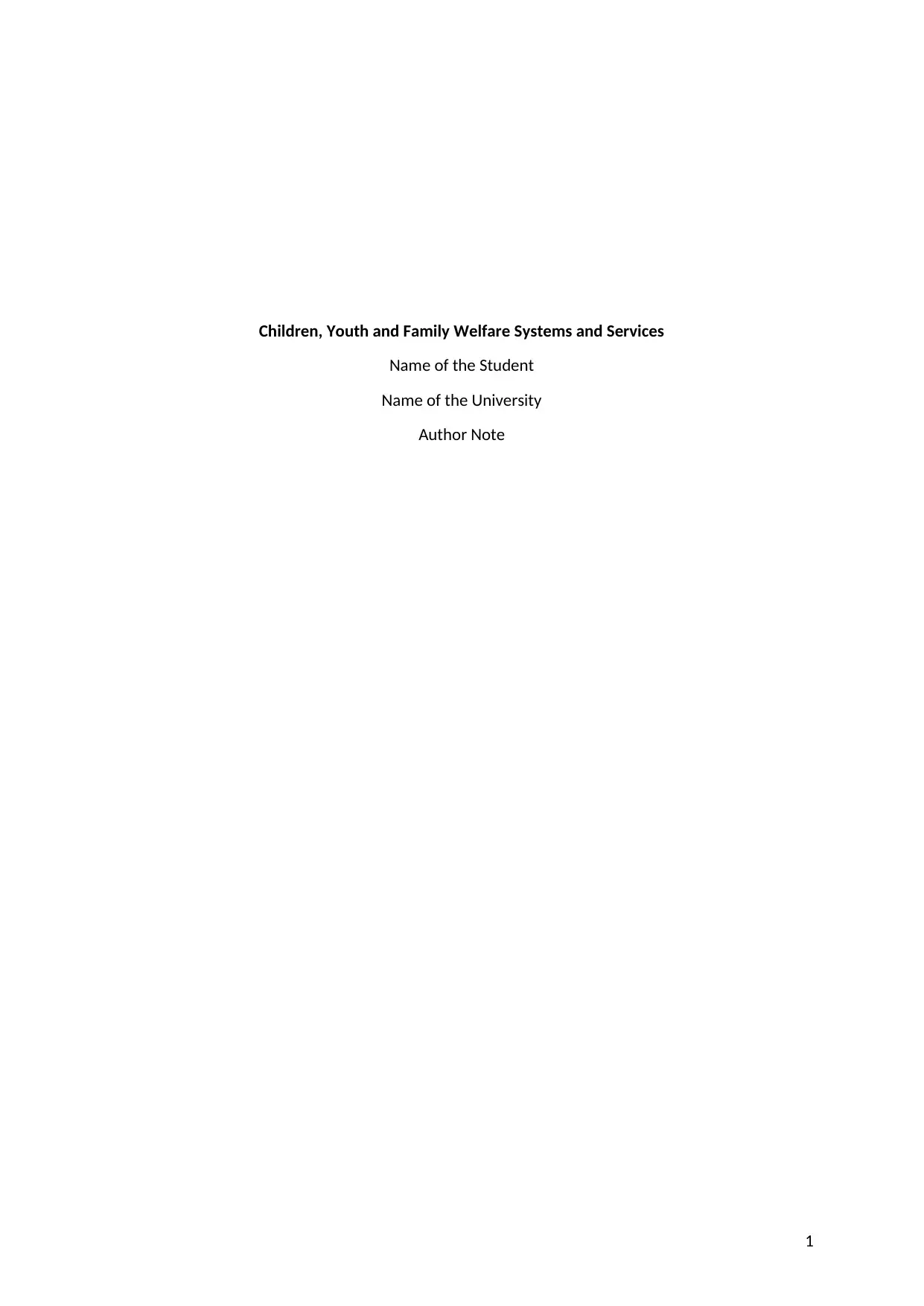
Children, Youth and Family Welfare Systems and Services
Name of the Student
Name of the University
Author Note
1
Name of the Student
Name of the University
Author Note
1
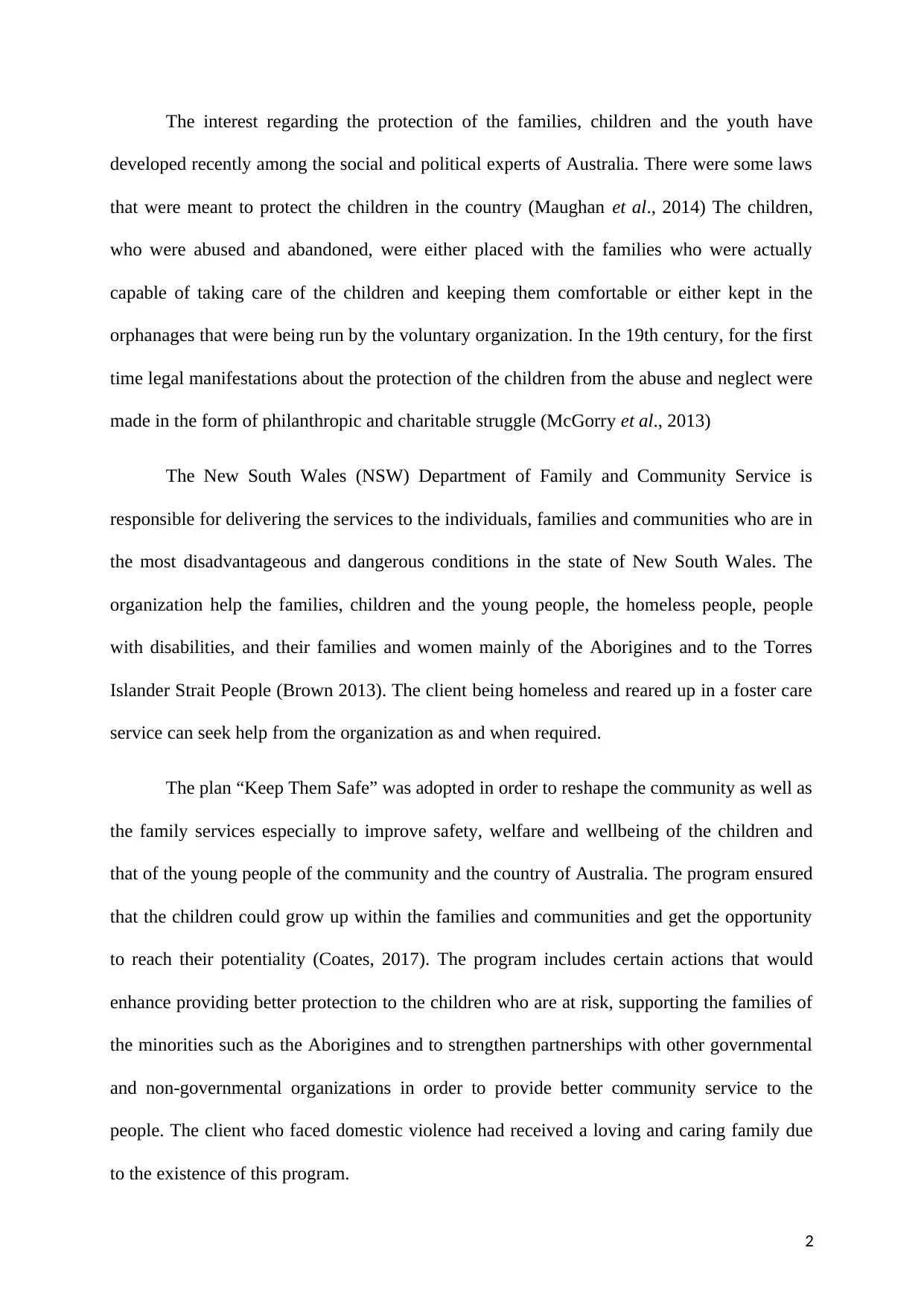
The interest regarding the protection of the families, children and the youth have
developed recently among the social and political experts of Australia. There were some laws
that were meant to protect the children in the country (Maughan et al., 2014) The children,
who were abused and abandoned, were either placed with the families who were actually
capable of taking care of the children and keeping them comfortable or either kept in the
orphanages that were being run by the voluntary organization. In the 19th century, for the first
time legal manifestations about the protection of the children from the abuse and neglect were
made in the form of philanthropic and charitable struggle (McGorry et al., 2013)
The New South Wales (NSW) Department of Family and Community Service is
responsible for delivering the services to the individuals, families and communities who are in
the most disadvantageous and dangerous conditions in the state of New South Wales. The
organization help the families, children and the young people, the homeless people, people
with disabilities, and their families and women mainly of the Aborigines and to the Torres
Islander Strait People (Brown 2013). The client being homeless and reared up in a foster care
service can seek help from the organization as and when required.
The plan “Keep Them Safe” was adopted in order to reshape the community as well as
the family services especially to improve safety, welfare and wellbeing of the children and
that of the young people of the community and the country of Australia. The program ensured
that the children could grow up within the families and communities and get the opportunity
to reach their potentiality (Coates, 2017). The program includes certain actions that would
enhance providing better protection to the children who are at risk, supporting the families of
the minorities such as the Aborigines and to strengthen partnerships with other governmental
and non-governmental organizations in order to provide better community service to the
people. The client who faced domestic violence had received a loving and caring family due
to the existence of this program.
2
developed recently among the social and political experts of Australia. There were some laws
that were meant to protect the children in the country (Maughan et al., 2014) The children,
who were abused and abandoned, were either placed with the families who were actually
capable of taking care of the children and keeping them comfortable or either kept in the
orphanages that were being run by the voluntary organization. In the 19th century, for the first
time legal manifestations about the protection of the children from the abuse and neglect were
made in the form of philanthropic and charitable struggle (McGorry et al., 2013)
The New South Wales (NSW) Department of Family and Community Service is
responsible for delivering the services to the individuals, families and communities who are in
the most disadvantageous and dangerous conditions in the state of New South Wales. The
organization help the families, children and the young people, the homeless people, people
with disabilities, and their families and women mainly of the Aborigines and to the Torres
Islander Strait People (Brown 2013). The client being homeless and reared up in a foster care
service can seek help from the organization as and when required.
The plan “Keep Them Safe” was adopted in order to reshape the community as well as
the family services especially to improve safety, welfare and wellbeing of the children and
that of the young people of the community and the country of Australia. The program ensured
that the children could grow up within the families and communities and get the opportunity
to reach their potentiality (Coates, 2017). The program includes certain actions that would
enhance providing better protection to the children who are at risk, supporting the families of
the minorities such as the Aborigines and to strengthen partnerships with other governmental
and non-governmental organizations in order to provide better community service to the
people. The client who faced domestic violence had received a loving and caring family due
to the existence of this program.
2
⊘ This is a preview!⊘
Do you want full access?
Subscribe today to unlock all pages.

Trusted by 1+ million students worldwide
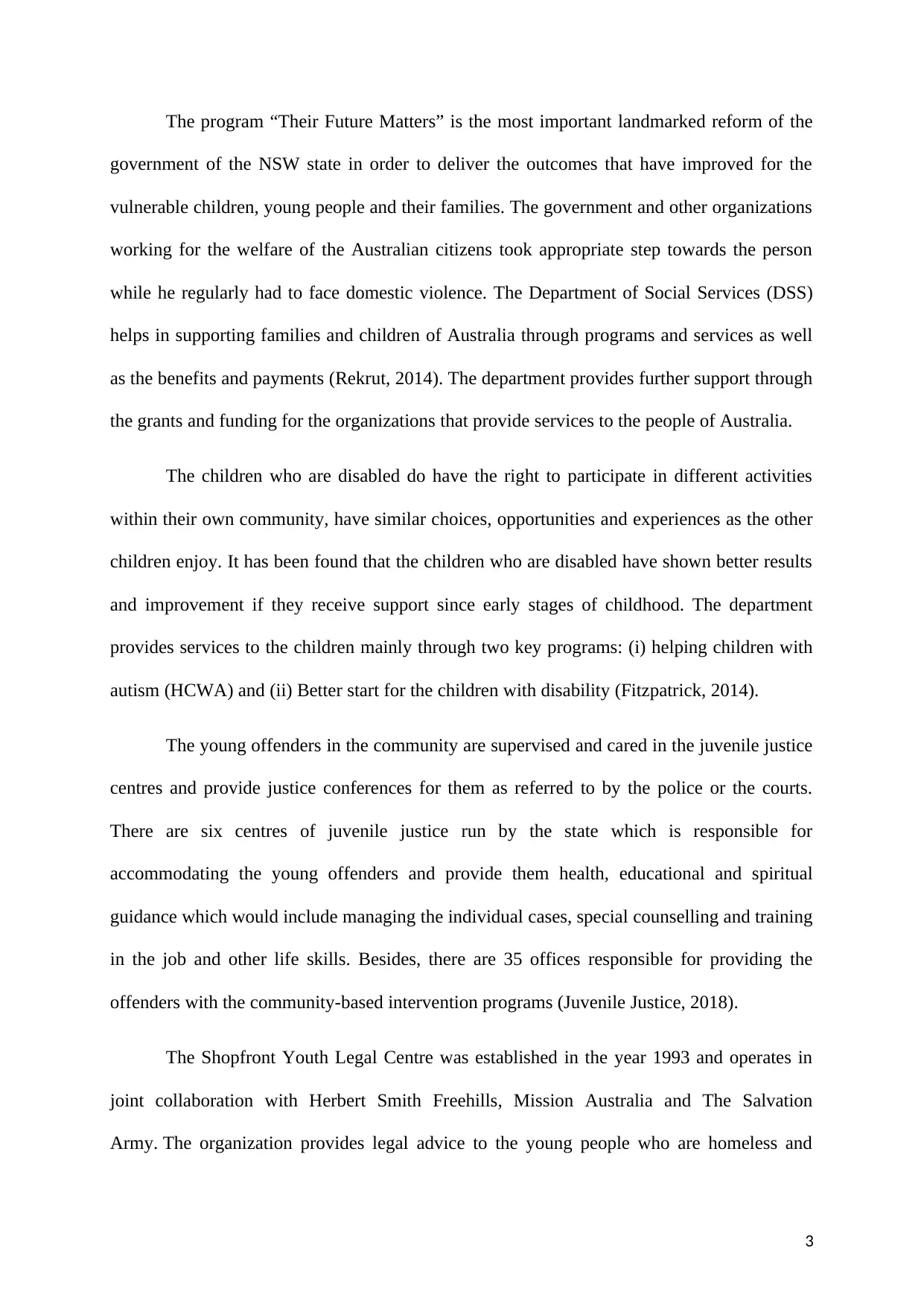
The program “Their Future Matters” is the most important landmarked reform of the
government of the NSW state in order to deliver the outcomes that have improved for the
vulnerable children, young people and their families. The government and other organizations
working for the welfare of the Australian citizens took appropriate step towards the person
while he regularly had to face domestic violence. The Department of Social Services (DSS)
helps in supporting families and children of Australia through programs and services as well
as the benefits and payments (Rekrut, 2014). The department provides further support through
the grants and funding for the organizations that provide services to the people of Australia.
The children who are disabled do have the right to participate in different activities
within their own community, have similar choices, opportunities and experiences as the other
children enjoy. It has been found that the children who are disabled have shown better results
and improvement if they receive support since early stages of childhood. The department
provides services to the children mainly through two key programs: (i) helping children with
autism (HCWA) and (ii) Better start for the children with disability (Fitzpatrick, 2014).
The young offenders in the community are supervised and cared in the juvenile justice
centres and provide justice conferences for them as referred to by the police or the courts.
There are six centres of juvenile justice run by the state which is responsible for
accommodating the young offenders and provide them health, educational and spiritual
guidance which would include managing the individual cases, special counselling and training
in the job and other life skills. Besides, there are 35 offices responsible for providing the
offenders with the community-based intervention programs (Juvenile Justice, 2018).
The Shopfront Youth Legal Centre was established in the year 1993 and operates in
joint collaboration with Herbert Smith Freehills, Mission Australia and The Salvation
Army. The organization provides legal advice to the young people who are homeless and
3
government of the NSW state in order to deliver the outcomes that have improved for the
vulnerable children, young people and their families. The government and other organizations
working for the welfare of the Australian citizens took appropriate step towards the person
while he regularly had to face domestic violence. The Department of Social Services (DSS)
helps in supporting families and children of Australia through programs and services as well
as the benefits and payments (Rekrut, 2014). The department provides further support through
the grants and funding for the organizations that provide services to the people of Australia.
The children who are disabled do have the right to participate in different activities
within their own community, have similar choices, opportunities and experiences as the other
children enjoy. It has been found that the children who are disabled have shown better results
and improvement if they receive support since early stages of childhood. The department
provides services to the children mainly through two key programs: (i) helping children with
autism (HCWA) and (ii) Better start for the children with disability (Fitzpatrick, 2014).
The young offenders in the community are supervised and cared in the juvenile justice
centres and provide justice conferences for them as referred to by the police or the courts.
There are six centres of juvenile justice run by the state which is responsible for
accommodating the young offenders and provide them health, educational and spiritual
guidance which would include managing the individual cases, special counselling and training
in the job and other life skills. Besides, there are 35 offices responsible for providing the
offenders with the community-based intervention programs (Juvenile Justice, 2018).
The Shopfront Youth Legal Centre was established in the year 1993 and operates in
joint collaboration with Herbert Smith Freehills, Mission Australia and The Salvation
Army. The organization provides legal advice to the young people who are homeless and
3
Paraphrase This Document
Need a fresh take? Get an instant paraphrase of this document with our AI Paraphraser
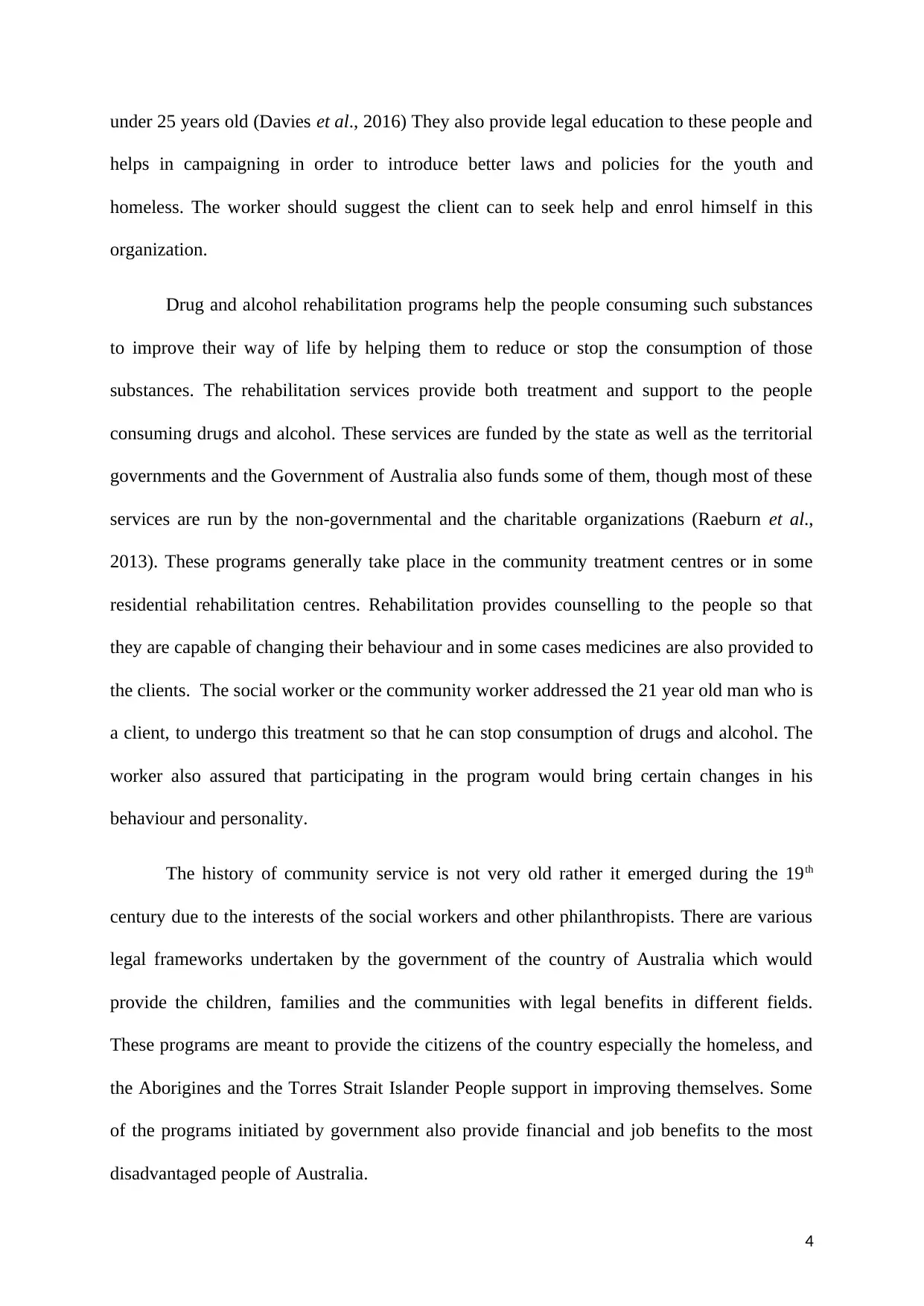
under 25 years old (Davies et al., 2016) They also provide legal education to these people and
helps in campaigning in order to introduce better laws and policies for the youth and
homeless. The worker should suggest the client can to seek help and enrol himself in this
organization.
Drug and alcohol rehabilitation programs help the people consuming such substances
to improve their way of life by helping them to reduce or stop the consumption of those
substances. The rehabilitation services provide both treatment and support to the people
consuming drugs and alcohol. These services are funded by the state as well as the territorial
governments and the Government of Australia also funds some of them, though most of these
services are run by the non-governmental and the charitable organizations (Raeburn et al.,
2013). These programs generally take place in the community treatment centres or in some
residential rehabilitation centres. Rehabilitation provides counselling to the people so that
they are capable of changing their behaviour and in some cases medicines are also provided to
the clients. The social worker or the community worker addressed the 21 year old man who is
a client, to undergo this treatment so that he can stop consumption of drugs and alcohol. The
worker also assured that participating in the program would bring certain changes in his
behaviour and personality.
The history of community service is not very old rather it emerged during the 19th
century due to the interests of the social workers and other philanthropists. There are various
legal frameworks undertaken by the government of the country of Australia which would
provide the children, families and the communities with legal benefits in different fields.
These programs are meant to provide the citizens of the country especially the homeless, and
the Aborigines and the Torres Strait Islander People support in improving themselves. Some
of the programs initiated by government also provide financial and job benefits to the most
disadvantaged people of Australia.
4
helps in campaigning in order to introduce better laws and policies for the youth and
homeless. The worker should suggest the client can to seek help and enrol himself in this
organization.
Drug and alcohol rehabilitation programs help the people consuming such substances
to improve their way of life by helping them to reduce or stop the consumption of those
substances. The rehabilitation services provide both treatment and support to the people
consuming drugs and alcohol. These services are funded by the state as well as the territorial
governments and the Government of Australia also funds some of them, though most of these
services are run by the non-governmental and the charitable organizations (Raeburn et al.,
2013). These programs generally take place in the community treatment centres or in some
residential rehabilitation centres. Rehabilitation provides counselling to the people so that
they are capable of changing their behaviour and in some cases medicines are also provided to
the clients. The social worker or the community worker addressed the 21 year old man who is
a client, to undergo this treatment so that he can stop consumption of drugs and alcohol. The
worker also assured that participating in the program would bring certain changes in his
behaviour and personality.
The history of community service is not very old rather it emerged during the 19th
century due to the interests of the social workers and other philanthropists. There are various
legal frameworks undertaken by the government of the country of Australia which would
provide the children, families and the communities with legal benefits in different fields.
These programs are meant to provide the citizens of the country especially the homeless, and
the Aborigines and the Torres Strait Islander People support in improving themselves. Some
of the programs initiated by government also provide financial and job benefits to the most
disadvantaged people of Australia.
4
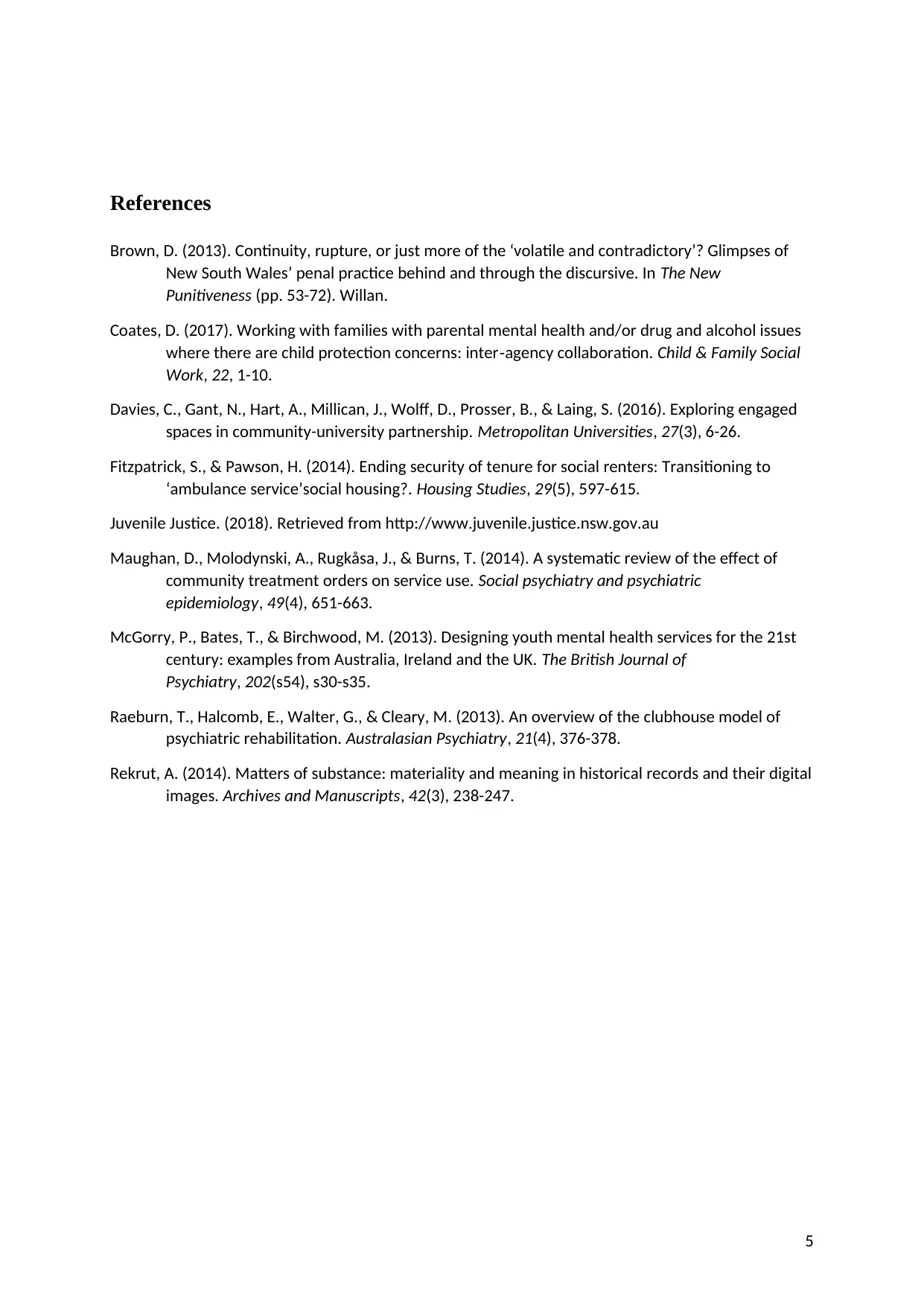
References
Brown, D. (2013). Continuity, rupture, or just more of the ‘volatile and contradictory’? Glimpses of
New South Wales’ penal practice behind and through the discursive. In The New
Punitiveness (pp. 53-72). Willan.
Coates, D. (2017). Working with families with parental mental health and/or drug and alcohol issues
where there are child protection concerns: inter‐agency collaboration. Child & Family Social
Work, 22, 1-10.
Davies, C., Gant, N., Hart, A., Millican, J., Wolff, D., Prosser, B., & Laing, S. (2016). Exploring engaged
spaces in community-university partnership. Metropolitan Universities, 27(3), 6-26.
Fitzpatrick, S., & Pawson, H. (2014). Ending security of tenure for social renters: Transitioning to
‘ambulance service’social housing?. Housing Studies, 29(5), 597-615.
Juvenile Justice. (2018). Retrieved from http://www.juvenile.justice.nsw.gov.au
Maughan, D., Molodynski, A., Rugkåsa, J., & Burns, T. (2014). A systematic review of the effect of
community treatment orders on service use. Social psychiatry and psychiatric
epidemiology, 49(4), 651-663.
McGorry, P., Bates, T., & Birchwood, M. (2013). Designing youth mental health services for the 21st
century: examples from Australia, Ireland and the UK. The British Journal of
Psychiatry, 202(s54), s30-s35.
Raeburn, T., Halcomb, E., Walter, G., & Cleary, M. (2013). An overview of the clubhouse model of
psychiatric rehabilitation. Australasian Psychiatry, 21(4), 376-378.
Rekrut, A. (2014). Matters of substance: materiality and meaning in historical records and their digital
images. Archives and Manuscripts, 42(3), 238-247.
5
Brown, D. (2013). Continuity, rupture, or just more of the ‘volatile and contradictory’? Glimpses of
New South Wales’ penal practice behind and through the discursive. In The New
Punitiveness (pp. 53-72). Willan.
Coates, D. (2017). Working with families with parental mental health and/or drug and alcohol issues
where there are child protection concerns: inter‐agency collaboration. Child & Family Social
Work, 22, 1-10.
Davies, C., Gant, N., Hart, A., Millican, J., Wolff, D., Prosser, B., & Laing, S. (2016). Exploring engaged
spaces in community-university partnership. Metropolitan Universities, 27(3), 6-26.
Fitzpatrick, S., & Pawson, H. (2014). Ending security of tenure for social renters: Transitioning to
‘ambulance service’social housing?. Housing Studies, 29(5), 597-615.
Juvenile Justice. (2018). Retrieved from http://www.juvenile.justice.nsw.gov.au
Maughan, D., Molodynski, A., Rugkåsa, J., & Burns, T. (2014). A systematic review of the effect of
community treatment orders on service use. Social psychiatry and psychiatric
epidemiology, 49(4), 651-663.
McGorry, P., Bates, T., & Birchwood, M. (2013). Designing youth mental health services for the 21st
century: examples from Australia, Ireland and the UK. The British Journal of
Psychiatry, 202(s54), s30-s35.
Raeburn, T., Halcomb, E., Walter, G., & Cleary, M. (2013). An overview of the clubhouse model of
psychiatric rehabilitation. Australasian Psychiatry, 21(4), 376-378.
Rekrut, A. (2014). Matters of substance: materiality and meaning in historical records and their digital
images. Archives and Manuscripts, 42(3), 238-247.
5
⊘ This is a preview!⊘
Do you want full access?
Subscribe today to unlock all pages.

Trusted by 1+ million students worldwide

6
1 out of 7
Related Documents
Your All-in-One AI-Powered Toolkit for Academic Success.
+13062052269
info@desklib.com
Available 24*7 on WhatsApp / Email
![[object Object]](/_next/static/media/star-bottom.7253800d.svg)
Unlock your academic potential
Copyright © 2020–2025 A2Z Services. All Rights Reserved. Developed and managed by ZUCOL.





